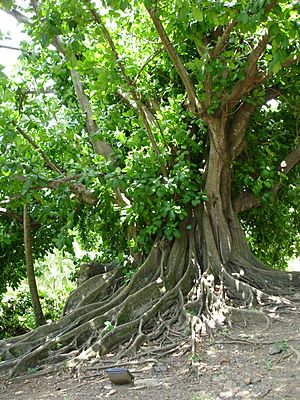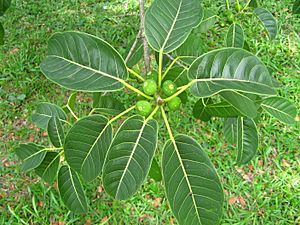Shortleaf fig facts for kids
The Shortleaf Fig (Ficus citrifolia) is a type of banyan tree. It's also known by other names like the giant bearded fig or wild banyantree. You can find this tree growing naturally in places like southern Florida, the Caribbean islands, Mexico, Central America, and northern South America, all the way down to Paraguay.
One way to tell the Shortleaf Fig apart from a similar tree, the Florida strangler fig (Ficus aurea), is by looking closely at its leaves. The Shortleaf Fig has much finer lines, or veins, in its leaves.
Quick facts for kids Shortleaf fig |
|
|---|---|
 |
|
| Scientific classification | |
| Genus: |
Ficus
|
| Species: |
citrifolia
|
Contents
What Does the Shortleaf Fig Look Like?
Shortleaf Fig trees can grow quite tall, often reaching about 15 meters (50 feet) high. They can also spread out very wide. This is because their branches can drop special roots called aerial roots. These roots grow down to the ground and then fuse, or join, with the main tree. This helps the tree spread out horizontally.
These trees have a wide, rounded top and light grey bark. They also have a milky sap inside. The leaves are dark green and shaped like an oval, with a rounded bottom and a pointy tip.
The Shortleaf Fig produces small flowers that are hidden inside its fruit. The fruit grows on long stalks that stick out from where the leaves meet the branches. When the fruit is ripe, it changes color from yellow to dark red. This fruit is sweet and can be eaten raw.
How the Shortleaf Fig Lives and Grows
Starting Life as an Epiphyte
New Shortleaf Fig trees often start their lives as an epiphyte. This means they grow on another plant, usually a tree, instead of in the ground. This helps them get enough sunlight and avoid competing for space on the ground.
As the Shortleaf Fig grows, it sends its roots down around the host tree. It commonly grows on palm trees, bald cypress, oaks, and other trees. Over time, the fig can actually strangle and take over the host tree as it gets bigger and stronger.
The Fig and Its Wasp Pollinator
The Shortleaf Fig has a very special relationship with a tiny insect called a agaonid wasp. This relationship is called a mutualistic relationship, which means both the tree and the wasp help each other. The fig tree needs the wasp to pollinate its flowers so it can make seeds. In return, the wasp needs the fig tree to lay its eggs and for its young to grow inside the fig fruit.
Each type of fig tree usually has its own special type of wasp that pollinates it. For the Shortleaf Fig, its pollinator is a wasp called P. assuetus. Because of this special connection, the Shortleaf Fig produces fruit all year long. This is important for the wasps to survive.
After the wasps pollinate the flowers, the figs ripen very quickly. A single Shortleaf Fig tree can produce a huge number of fruits, sometimes up to 1,000,000! These fruits are small, about 1 to 2.5 centimeters (0.4 to 1 inch) across. Many animals eat these ripe fruits, and when they do, the seeds are spread far and wide through their droppings.
Other Creatures in the Fig Tree
Besides the pollinating wasp, many other small creatures live inside the Shortleaf Fig's fruit or around the tree. These can include:
- Other types of wasps that don't pollinate the fig.
- Tiny worms called nematodes. Some of these worms are carried by the pollinating wasp, and others are parasites that attack the pollinating wasp itself.
- Mites, which are tiny spider-like creatures.
- Midges, which are small flies that lay their eggs in the fig fruit walls.
- Rove beetles, which are insects whose adults and larvae eat the fig wasps.
Why the Shortleaf Fig is So Important
A Keystone Species
The Shortleaf Fig is considered a keystone species in tropical areas. A keystone species is like the most important stone in an archway – if you remove it, the whole arch might fall apart. In nature, it means a species that many other plants and animals depend on.
Figs are a huge part of the diet for more animal species than almost any other tropical fruit. Since the Shortleaf Fig produces fruit all year, many animals, like monkeys, birds, and other creatures, eat only figs when other fruits are hard to find.
Also, the Shortleaf Fig tree has a unique trunk that can be knobby, hollow, and full of spaces. This provides a home for thousands of small animals, including insects, rodents, bats, birds, and reptiles.
The good news is that the Shortleaf Fig is common and is not currently in danger of disappearing.
Interesting Facts About the Shortleaf Fig
Genetic Mosaics
Sometimes, a Shortleaf Fig tree can actually join with other types of fig trees. When this happens, it creates a combined tree that is a genetic mosaic. This means different parts of the tree have different genetic information.
Scientists think that many strangler fig trees might be genetic mosaics. It's not fully understood how this affects when the tree flowers. If different parts of the same tree flower at different times, it could help the pollinating wasp populations survive better, even if there aren't many fig trees around.
History and Barbados
There's a theory that the Portuguese name for the Shortleaf Fig, "Os Barbados," gave the island of Barbados its name. The tree is even shown on the coat of arms of Barbados. When one very old Shortleaf Fig tree, over 100 years old, was removed from the island, it caused a lot of attention because of its importance.
Possible Medical Uses
Scientists are studying the Shortleaf Fig to see if it could have medical benefits. An extract from the tree might be helpful for people undergoing chemotherapy treatments.
Images for kids
See also
 In Spanish: Higuerón para niños
In Spanish: Higuerón para niños



